planning the outdoor play space, Julie Mountain looks at Change and
Chance.

Pioneered by a landscape research team at the University of British Columbia, 7Cs is a strategy that can inform the design of early childhood outdoor spaces. So far in this series, I have explored what 7Cs looks like in practice by examining how the Character of a space influences its use and why Clarity is important, how Context and Connectivity enrich outdoor play, and the significance of Challenge outdoors (see the information column at the end of this piece). I deliberately left Change and Chance until last.
For me, these two pieces of the 7Cs jigsaw truly encapsulate the sheer joy of what it means to be very young and to be playing outdoors. As we grow older, life becomes more regimented, more organised and more prepared. Opportunities to react to unexpected events become rarer - because most things that happen to us are more or less anticipated. And, of course, we play outdoors less as adults.
Much is now understood about the intellectual, social and emotional benefits of a playful attitude in adulthood and I won't go into it here. However, it is worth reminding ourselves of the quote attributed to George Bernard Shaw: 'We don't stop playing because we grow old; we grow old because we stop playing.'
The 'awe and wonder' we seek to help children experience is tangible; it is just that adults' jaded eyes and busy lifestyles prevent us from genuinely appreciating subtle changes or enjoying chance encounters. Your outdoor play space should be a dynamic, flexible and opportunistic place where the comfort and security of familiarity rub up against exciting encounters, new vistas and accidental fun.
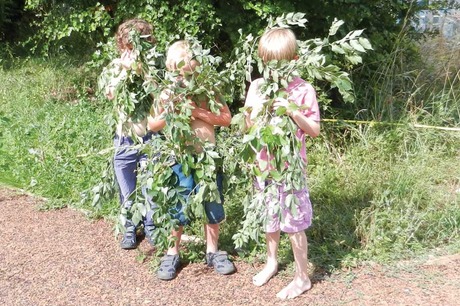
CHANGE - WHAT DOES IT MEAN?
The notion of 'change' manifests itself in three clear and distinct ways.
- Change partly references the changes children themselves are experiencing; every day, their bodies are slightly larger than the day before, a little stronger, more agile. They can reach further, jump higher, no longer squeeze into a hidey-hole. Children's understanding of the world grows daily. It is vital that outdoors responds to the changing physical and emotional needs of young children, and this is not always easy where a space caters for babies, toddlers and pre-schoolers.
- Change is also about seasonal change - the rise and fall of perennial plants; the deep shadows and frost pockets of winter; snowdrifts of blossom; the slow and steady growth of a tree, upwards and outwards, from abundance to emaciated and back again, year in year out. Within a season, wonderful swishy grasses, willows and bamboos shoot up from nothing to become giants, overtaking the growing children and providing a refreshingly varied perspective outdoors and modifying how it might be used.
- The built landscape itself must also present change. Environments rich in play potential offer a wide range of scales, sizes, shapes and levels. Wide open spaces allow big movements and joyful, noisy interactions; tiny nooks and crannies allow children to take refuge; tunnels and enclosures afford drama and tension; towers and platforms lift spirits and voices as well as bodies.
In the 7Cs guidance, Professor Susan Herrington and the research team point out that good-quality outdoor spaces need to 'accommodate different numbers of children and different uses' and should, therefore, incorporate sub-spaces, level changes, a variety of materials (which themselves should change over time) and zones that are 'fluid' - overlapping and connected.
Young children are fascinated by change. In providing a robust and logical basic structure to an early childhood play space, we ought not to forget the appeal of chance and change. I'm often asked about continuous provision outdoors - what does good-quality continuous provision look like?
Settings often express concern that their outdoor play offer will be undervalued (by parents or Ofsted, perhaps) if everything they have is not out and available every day. In fact, as with indoor learning through play, continuous provision is about having key components - those really vital core elements - available every day. The 7Cs concept of 'change' then comes into play, with resources being alternated, withheld or combined in ways that provide children with new and rich experiences.
Managing resources as well as the environment helps sustain children's interest outdoors, and this is one of the reasons I feel so strongly about the prominence of natural materials and natural elements in outdoor play; a gaudy rubberised surface looks the same every day, but a patch of grass never looks the same two days in a row. A fixed bench is always a bench (except when it is being a den, of course), but loose log slices and tree trunks move and connect to create bespoke seating areas exactly the size and shape a child needs at any particular time.
It is important that the fundamental elements of your outdoor provision - the sand, the water, the demanding physical challenges, the refuges and open spaces - can be adapted and changed every day to suit the needs of these children, today. What children want to do outdoors might be affected by the weather, the themes and topics being explored indoors, current affairs (especially sporting events), their own health and emotional well-being and of course the resources you have made available. These changes are good and allow children to invent rich and enticing play scenarios for themselves.
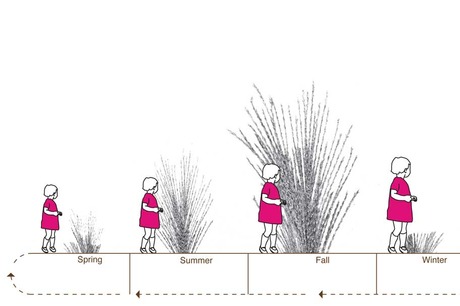
CHANCE - WHAT DOES IT MEAN?
Philosophers may disagree over whether it is 'chance' or 'choice' that determines the path our lives take, but there can be no question that chance makes our lives extraordinary, if tricky sometimes.
Chance is a difficult notion for designers to understand and interpret; as the 7Cs guidance points out, they 'typically design for permanence'. However, my experience as a designer of early childhood play spaces has shown me that early years practitioners have a very sound grasp of the importance of chance in children's development.
While we can speculate about what might happen when a particular set of circumstances combines (for example, a sunny day, a sandpit, half a dozen children and a pile of sticks), we can't know for certain, and that is the beauty of loose parts resources - open-ended, flexible objects, rich in unknowable affordances.
The design of our play spaces must allow for chance. While we can't plan what the 'chances' might be, we can make it easier and more likely that chance events will occur by careful choice of resources, intelligent structuring of the space and by examining our own attitude to risk-taking.
If a space rarely changes, and offers few opportunities for chance events, children will soon become bored with it and this can lead to disrespect of the equipment and possibly even one another.
Fully engaged children, excited by the prospect of outdoor play and curious about what might happen, have been shown to display higher levels of physical activity and well-being1. It is in our interest to create spaces and provide resources that sustain interest and encourage movement.
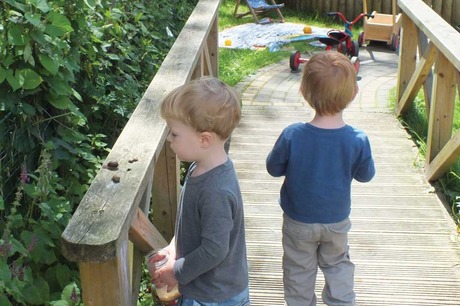
So what can you do to maximise the value of chance events?
- Focus resourcing on loose parts rather than fixed equipment, enabling children to shape their play differently each day.
- Zone outdoors so that intensive activities take place around the periphery, allowing plenty of room for manoeuvre in the centre. A play space crammed with fixed features leaves little to the imagination.
- Introduce more natural features: trees, shrubs, planters, vegetable beds. Not only do natural elements change throughout the year, but the changes can spark new ideas - drifts of leaves, blossom floating through the air, drooping strawberries, caterpillars and snails.
- Create mystery. Nooks and crannies are important features. Secrecy and refuge are vital components of childhood and within your safe, secure outdoor space, it is perfectly possible to enable children to explore spontaneously and hide away
- Encourage problem solving and exploration. Provide access to resources and materials that will allow children to make and break things. Hollow blocks, crates, sticks and den-building materials are a good start and remember to use planted areas to draw children into exploring with their whole bodies.
- Be generous with sand, water and mud and allow mess. Sand should take up as much space as you can spare and try to make sure there are places where sand, water, leaves, mud and gravel can become mixed up. Clever storage will ensure children are able to access the tools they need - and clear them away again after a session, reinforcing the need to take responsibility.
INNOVATING OUTDOORS: KINDLING FOREST SCHOOL
Forest schools add a new dimension to the 7Cs, not least because the spaces and places used by forest schools tend not to be 'designed' at all and are rarely immediately adjacent to settings. Instead, forest school practitioners adapt natural spaces and install temporary features to accommodate their programme, with children visiting regularly, if not always frequently.
Lily Rowe-Horseman runs Kindling, a forest school play and training company, and insists that not only are Change and Chance absolutely vital elements in the forest school offer, the principles can be translated easily into every day outdoor play.
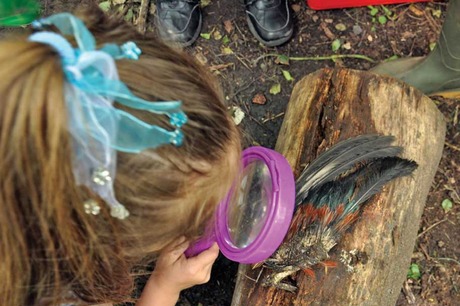
She explains, 'Only last month I was minibeast hunting with a group of children when we happened upon a pheasant's wing. It had clearly been chewed off the animal's body, probably by a fox, and on the face of it was pretty horrible looking.
'Some of the children reacted with revulsion (as did one of my other adult helpers!), but I flicked the wing over with a stick and children were suddenly faced with the beautiful, shimmering iridescent feathers.
'They were excited - full of expressive language, searching for the words to describe what they could see. Children were amazed by the colours, and utterly absorbed by this chance find. The adult response here was critical; I had no idea we'd come across the wing, but I was quick to take up the opportunity to share something unique and special with the group.
'Since then, I've reflected extensively on what else we could have done, how I might tackle this again, should we ever find another wing. The truth is, you can't plan for "chance" encounters like this, and that's exactly what makes them so memorable.'
Learning and play in the forest can be truly unpredictable. 'Indoors,' says Ms Rowe-Horseman, 'the spaces and activities are adult controlled and confined by four walls and a ceiling. Outdoors, anything might happen and children are able to manipulate and react to events.'
The quite dramatic changes that occur in the forest from week to week are starkly noticeable for children who are immersed in it as part of an ongoing forest school programme. Recognising and responding creatively to environmental change are fundamental features of forest school - and with forward planning in your setting, can be fundamental to your own everyday practice.
However, learning outdoors can influence more significant changes in children's lives. Ms Rowe-Horseman shares an illuminating story: 'One of the boys who joined us recently lives in a family for whom outdoors is not a cultural priority. Reflecting on the experiences this boy had enjoyed with us at Kindling, he told me, "I've never climbed trees before. I love lying in them. My mum says we can go to the woods sometime because I love it so much."
'This was a huge leap forward for this family - the child's confidence in his own ability and his desire to share his new passion meant that the rest of his family were able to change their own attitudes and embrace the risk and unpredictability of outdoors.'
KEY PRINCIPLES
Ms Rowe-Horseman's key principles for embracing Chance and Change in everyday practice include the following points.
- Enable risk taking - accept that you may not know what the outcome of an event might be.
- Reflect on chance events - what would you do differently if it did happen again?
- Immerse children in the magic of outdoors - allow them time to appreciate change and develop an understanding of the space and their place in it.
IN SUMMARY
Exploring the 7Cs in practice has been a fascinating journey. It is a down-to-earth, realistic strategy that any early childhood setting can use to audit their own play provision.
Alongside these articles, I have produced downloads to help you think about each 'C' in the context of your setting. Why not print them off and start looking at how adaptable and exhilarating your outdoor space really is?
- Character: the overall feel of your space; the messages it conveys.
- Context: how elements of the space interact with one another and with the neighbourhood.
- Connectivity: how children move around and understand the space as a whole.
- Change: change in scale and materials, seasonal change and the changing needs of the children.
- Chance: allowing for, and making the most of, the unexpected.
- Clarity: a logical layout that enables children to play freely across the whole space.
- Challenge: introducing risk and adventure though resourcing and adult attitudes.
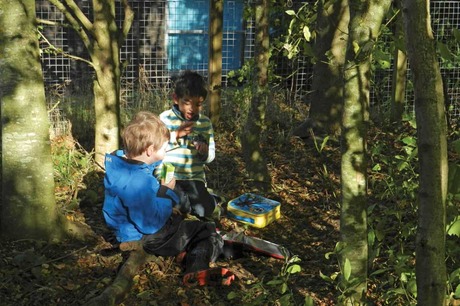
CHANCE AND CHANGE: WHAT NEXT FOR YOUR SETTING?
- Download the 7Cs guide, www.wstcoast.org/playspaces/outsidecriteria/7Cs.pdf
- Each article in this series is accompanied by a guidance note, aimed at helping settings apply the 7Cs principles to their own circumstances. Visit www.nurseryworld.co.uk for each article to download the corresponding guidance. The guidance for this article focuses on helping you identify opportunities for making the most of change and chance every day.
REFERENCE
1. Including Simon Nicholson's Theory of Loose Parts; Professor Ferre Laevers' Scales of Well-being; RSPB Connecting with Nature report.
MORE INFORMATION
- Kindling, www.kindlingplayandtraining.co.uk
- Landscapes for Early Childhood is a UK network of designers and practitioners that specialise in working alongside schools and settings to create child focused, innovative outdoor spaces. Join the debate on LinkedIn or Facebook.
- Parts 1-3 of this series have provided an overview of the approach and looked at Character (Nursery World, 7 April), Context and Connectivity (Nursery World, 5 May) and Clarity and Challenge (2 June) (see related articles, below).
- The Forest School Association provides information about forest schools across the UK, www.forestschoolassociation.org
- The UK's school grounds charity Learning Through Landscapes has lots of material written especially for early years settings, much of it free to download at www.ltl.org.uk
- This approach to designing child focused outdoor play spaces has greatly influenced my own work since I first heard Professor Susan Herrington speak about it two years ago. You can contact me via www.playlearninglife.org.uk.
Julie Mountain is an early childhood landscape designer and director of Play Learning Life CIC Play. www.playlearninglife.org.uk









